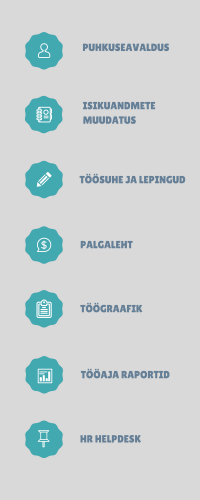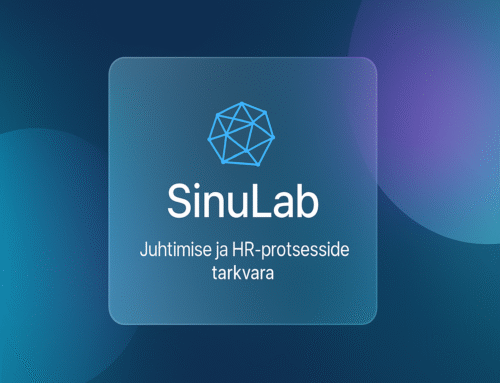
Töötaja iseteenindus (Employee self-service) mõnikord nimetatud ka kui „Töötaja portaal“ on kaasaegse organisatsioonitarkvara lahutamatuks osaks. Töötaja iseteenindus (edaspidi TiT) võimaldab tööandjal kaasata töötajaid erinevatesse juhtimise ja töötajate arendamise protsessidesse.
Kõik need tegevused, mis varasemalt on olnud kas paberil või mille tegemiseks on pidanud minema eraldi juhi või ka (personali)spetsialisti juurde, on TITis tehtud kättesaadavaks nii töötajale, kes vajadusel infot sisestab ning juhile, kes tegevusi kinnitab, ning spetsialistile, kes andmeid administreerib ja kasutab.
Töötaja iseteenindus on kasutusel mitmes inimressursi juhtimise valdkonnas
- Väga levinud on TiT avalduste haldamises ja administreerimisel. Näiteks puhkusevaldusteesitamine töötaja poolt, juhi-poolne kinnitamine. Või ka isikuandmete muutmine, kui peaks näiteks perekonnanimi, elukoht või isikudokumendi andmed muutuma.
- Ka uus GDPR soosib lahendusi, kus töötajal on ülevaade tema kohta kogutavast infost, mis teeb tööandja elu märgatavalt lihtsamaks ja ajasäästlikumaks, sest kaob vajadus paberkandjal või failidena infot kokku koguda ning seda töötajale edastada.
- Veel kasutatakse TiT lahendusi palgaarvestuses, kus palgalehti ei saadeta enam e-postile vaid töötajal on igal ajal võimalik oma palgaandmeid ja selle ajalugu iseteeninduse portaalist vaadata.
- Väga mugavad ja vajalikud on elektroonilised töögraafikute lahendused, millele töötajad ligi pääsevad ja saavad teha muudatusi/kooskõlastusi vastavalt vajadusele.
- Samuti võimaldavad uuemad lahendused töötajatel ise sisestada ja juhil kinnitada töötatud tööaega (töötunde), mis on sisendiks palgaarvestusele.
- Suuremates organisatsioonides on TiT seotud ka personalivaldkonna kasutajatoega (HR Helpdesk), kus töötajatel on onlines võimalik saada kiirelt vastuseid lihtsamatele küsimustele või saata põhjalikumaid päringuid, mis registreeritakse ja millega süsteemselt tegeletakse.
Kõik need lahendused kokku aitavad juhtidel ja tugitöötajatel administreerida personalitöö protsesse palju kiiremini kui seda seni tehtud. Kogu info on saadaval ühes kohas, muudatusi saab teha operatiivselt ning ka juht saab omapoolseid kinnitusi teha kiirelt.

Töötaja iseteeninduse lahendusi kasutatakse ka töötajate arendamisel (varasemalt nimetatud kui talendijuhtimine)
- Üsna levinud on töötajate uuringute lahendused, kus uuringus osalejad saavad sisestada vastuseid ja uuringu läbiviijad neid hiljem mugavalt analüüsida ja esitleda.
- Teine levinud kasutusala on erinevate õppematerjalide kättesaadavaks tegemine ja hoiustamine. Näiteks slaidid möödunud koolitusest, mida enam väga väja ei prindita või juhendmaterjalid, kirjeldused tööprotsesside kohta, samuti video-klipid ja pildimaterjal, mis on vajalik õppe eesmärgil. E-õppe lahendusi iseteeninduse keskkonnas on veelgi ja paljud suurettevõtteid neid ka edukalt kasutavad.
- TiT keskkonnas saab läbi viia erinevaid teste, hallata ja anda 360 tagasisidet, kompetentside ja käitumise hindamisi.
- Eestiski väga levinud praktika arenguvestluste näol on oma koha leidnud TiTis. Töötajad ja juhid saavad kogu vestluste ettevalmistuse ja dokumenteerimise tegevuse viia digitaalsesse keskkonda. Erinevad Case Study’d kinnitavad, et arenguvestluste digitaalne protsess nõuab 60% vähem ajakulu võrreldes varasemaga.
- Kui varasemalt lõid ettevõtted eraldi intraneti, kus töötajatel oli võimalik omavahel suhelda ja infot vahetada, siis uuemad TiT lahendused kombineerivad mõlemad pooled – intranetist saab üks osa töötaja iseteeninduse portaalist, mis sisaldab ka meeskondlikku ja sotsiaalset suhtlemisvõimalust.

Miks on töötaja iseteenindus kasulik?
Paljud organisatsioonid on leidnud, et töötajate iseteenindus annab võimaluse jagada töötajatega rohkem nendega seotud olulist infot ja teha seda ressursisäästlikult.
Töötajatele annab iseteeninduse kasutamine hea võimaluse omada pidevalt ülevaadet oma andmetest. Tänu sellele on andmed kvaliteetsemad ja neid saab operatiivselt ajakohastada.
Juhtidele annab TiT juurde seni admnistreerimisesele kulunud aega. Juhid saavad teha kinnitamisi elektrooniliselt, omavad koheselt vajalikku infot ja ülevaadet andmetest, mis puudutab nende meeskonnaliikmeid.
Kõige olulisem on aga see, et TiT aitab organisatsioonil personalitöö protsesse ja tegevusi oluliselt tõhusamaks ja kiiremaks muuta. Jääb ära andmete mitmekordne sisestamine ja tegevuste dubleerimine.
On eksiarvamus, et TiT on kasulik vaid suurtele organisatsioonidele ning väike- ja keskmiste ettevõtete puhul ei ole sellest märgatavat kasu.
Pigem on aga olukord vastupidine, sest just väike-ja keskmistes ettevõtetes teevad administreerivaid tegevusi väga suures osas juhid, ning ressurss mis selle alla kulub on üüratu. Selle asemel saab juht keskenduda ja pühenduda äritegevusele ja oma töötajate suunamisele.




